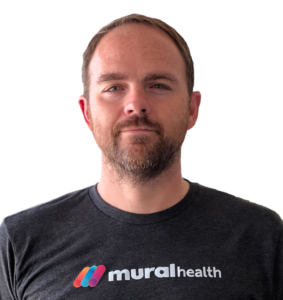Clinical Researcher—April 2023 (Volume 37, Issue 2)
TRIALS & TECHNOLOGY
A Q&A with Sam Whitaker, Co-Founder and Co-CEO of Mural Health
By 2027, the clinical trials software market will be worth an estimated $2.1 billion,{1} making it one of the world’s fastest growing technology sectors—and fertile ground for start-ups with ways to make research safer, faster, or more efficient.
But what is it really like to operate in this highly specialized space, what challenges can entrepreneurs expect to encounter, and how quickly will they, realistically, be in a position to cash out?
Helping us explore these topics is Sam Whitaker, founder and CEO of multiple clinical research technology companies. These include Greenphire, which launched the first patient payment system in 2008, and his latest venture, Mural Health, a patient management platform that aims to make it as easy as possible to take part in clinical trials.
You founded the first clinical trials payment financial technology (fintech) company back in 2008. How did that come about?
 When I was at college, I did some work at Pennsylvania Hospital and wanted to go to medical school. For one reason or another, that didn’t happen. I decided to major in philosophy, because I enjoyed flexing my brain to thing about abstract problems, and after graduating in 2002, I became an investment banking analyst. I soon realized that didn’t really suit my personality, and ended up working at a fintech start-up, Ecount, just outside Philadelphia.
When I was at college, I did some work at Pennsylvania Hospital and wanted to go to medical school. For one reason or another, that didn’t happen. I decided to major in philosophy, because I enjoyed flexing my brain to thing about abstract problems, and after graduating in 2002, I became an investment banking analyst. I soon realized that didn’t really suit my personality, and ended up working at a fintech start-up, Ecount, just outside Philadelphia.
It was here that I came up with the idea of developing a technology that would help pharmaceutical companies make payments to clinical trial participants. It came from a combination of the experience I had at the start-up, and my work at the hospital when I was a student.
How did you make the jump from working at a fintech to starting a company in the clinical trials space?
I knew I wanted to start a company—that I didn’t want to work for somebody else—and I had experience in payment technology. My idea was to build a software that would increase the value of technology beyond just moving money from point A to point B and was designed to meet the needs of one specific industry. Today, you would call it a “vertically integrated payments business,” but that terminology didn’t exist at the time.
People often ask me how I identified clinical research as an opportunity, but it wasn’t really like that. In fact, when I made a list of the industries that could benefit, drug development was number nine. Our main requirement was that we had to be first. We didn’t just want to “make a better mousetrap,” because while it may have been easier, it would have been less interesting. When we looked into clinical trials, we saw that no one had done what we wanted to do before. That was enough for us to make that commitment and move forward.
I read an article once that compared the way entrepreneurs and MBA graduates work. It said that an MBA graduate is like a chef who finds a recipe then goes to the store to buy all the necessary ingredients. An entrepreneur, however, goes into the kitchen, takes an inventory of the ingredients that are already in the cupboards, and works out what they can make with them. The process of starting that first business was very much like the later scenario. We checked the shelves, saw what we had to work with, and then created something new.
What were the biggest challenges and how did you overcome them?
There is a certain amount of agility that is needed to be successful, and definitely a component of luck, but the most critical skill to have is problem solving. At the start of this journey, we had challenges being fired at us from all angles: from vendors, clients, employees, regulators, and investors, so we got very good at solving problems.
In the early days, we had to convince the industry that what we had created was even necessary. I remember one of our earliest investors saying that patient payments weren’t an issue. But my point was that just because you are not hearing about it doesn’t mean that people are fine with the status quo—they just don’t know any better. It is like the difference between snail mail and e-mail. This was an opportunity to operate in a more efficient way and we had to demonstrate that.
We worked with a couple of sites to find out exactly how patient payments were being made. We found many manual steps, within many painfully bureaucratic processes that, in aggregate, were costly to universities and research sites, and had a negative impact on user experience from the participants’ perspective. No one had ever quantified that or tried to solve the problem, so there were some people our solution would resonate with, and others who just wouldn’t believe that it was an issue.
I think this is true with all kinds of innovation, especially within the clinical research space, and “expect to demonstrate value” is something I would say to anybody wanting to enter this space.
What makes a clinical research technology start-up successful?
As we were outsiders coming into the space, we were able to look at things a little differently. The way we approached development was unique at the time, and probably still is now.
The sponsor is the one paying for the product, but the site and, more importantly, the patient are the ones using it. If they do not like using it, they will not stick with it, and, eventually, the sponsor won’t use it either. From a design perspective, then, we saw the patient as our primary user and the site as our primary business user, which made the sponsor of tertiary importance. We focused on delighting users, which in turn created more value for the customer.
It’s different from what has been done in the past, but I think it is exactly what we should all be doing in this space. Many clinical tech businesses still tend to be very client focused, and I think that is a mistake.
What does a successful exit look like in this space?
We had three exits along the way. We started it late 2007/early 2008, and in 2011 we sold some stock to the venture capital firm we were partnered with, which was a relatively small. but really meaningful, moment in our lives. I left the business in early 2016, and the management team grew it from there, before the final exit in July 2021.
It was 13 years, start to finish, but if you look at companies that have gone from “zero to hero” in this space, a decade is probably a good estimate. I think Greenphire took a little longer because we were the first in the area, so it took us a while to define the space and get the industry on board.
Because it is so highly regulated and specialized, I don’t believe this space will accommodate a hyper-growth business. Often, raising a ton of money is a mistake because it is very hard to get the exponential, top-line growth you might get in a more generalized, cross-vertical tech space.
Of course, there are always exceptions, but I think 10 years from start-up to exit in this space is a good rule of thumb.
What’s next for you?
I have co-founded a new patient management platform, Mural Health. We all know that recruitment and retention are huge problems in clinical trials, so we want to make taking part as easy as possible for the volunteers.
The vision is to manage all of the touchpoints between a patient and a clinical trial, but we can’t do that from day one, so we are focusing on four areas that all embrace the participant-first mentality. We are launching with a next-generation payment solution, an in-app transportation feature, robust two-way communication, and participant analytics. That means the app will periodically ask the participant about his or her experience in the study, so that, longer term, sites and sponsors will be able see who is at risk of dropping out and take action.
Again, we are focusing on the end-user—on the patient and the site—even if they are not the ones paying for the technology. Because if you cannot satisfy the end-users, you will never satisfy the sponsor.
Reference
- Clinical trials software market to reach $2.1 billion by 2027. Web-based delivery system gaining momentum – Arizton. 2022. https://www.globenewswire.com/en/news-release/2022/08/30/2507172/0/en/Clinical-Trials-Software-Market-to-Reach-2-1-Billion-by-2027-Web-Based-Delivery-System-Gaining-Momentum-Arizton.html
Sam Whitaker is from suburban Philadelphia, Pa., (Delaware County) and is a graduate of the University of Pennsylvania.



